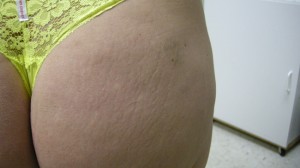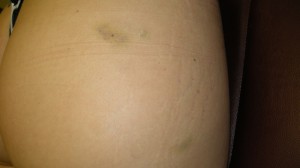The following is a guest post by expert Dr. Jon Rubenstein
Imperfections of the body and skin are a serious problem across America. One of the most serious imperfections that face both men and women today is stretch marks, or “striae”. These marks are a form of scarring of the skin. Stretch marks are caused by the stretching and tearing of the dermis, or outmost layer of skin. They are often the result of “Yo-Yo Dieting” which is the rapid expansion and contraction of skin. Pregnancy, muscle building, and surgical implants are some of the other common reason that these “stretch marks” develop. The marks, or tears, diminish over time, but they leave deep grooves which never disappear completely on their own.
Stretch marks can appear anywhere on the body, but are most likely to appear in places where larger amounts of fat are stored. The most common sites where stretch marks are found are the abdomen specifically around the navel area, breasts, thighs, hips, and buttocks. Weight lifters and muscle builders also experience these marks quite often in their upper arms, both over and under.
What causes stretch marks? Stretch marks are caused by the prevention of fibroblasts, which form collagen and elastin skin fibers. Without the formation of collagen and elastin fibers, skin will not grow taut. This creates a lack of supportive material beneath the skin as it is stretched out. Skin subjected to more force than it can handle biologically will tear and turn into these stretch marks.
There are various treatments today that claim to improve the appearance of stretch marks. Laser treatments, surgical tummy tucks, radiofrequency, and cover creams all purport to help hide or improve your scarring. However, with a new medical procedure that involves the use of PRP, stretch marks can actually be HEALED and ELIMINATED close to 100%.
To understand why PRP works on stretch marks, we must first understand that the science of PRP is based on what is known as the “healing cascade”, which is a series of regeneration and remodeling steps in the body. When tissue is injured, the body signals itself to increase production of “signal proteins” to be used at the site of trauma. These signal proteins include platelets, white blood cells, and mesenchymal or “adult” stem cells. The growth factors contained in the signal proteins concentrated in PRP create the production of new collagen and elastin.
So, how is PRP used to actually heal stretch marks? After preparation of the site, which induces fibroblasts, PRP is injected into the collagen under the skin using one inch spacing along a horizontal line. The lines are separated by about 1 ½ inches vertically. The entire area being treated is injected under these conditions. These injections of PRP release their growth factors and cells into the area of stimulated collagen. Based on the healing cascade, the release of growth factors increases the amount of collagen being produced, helping the skin to a tauter state. After the PRP is injected into the area, more PRP is used as a topical covering. The PRP is mixed with Thrombin JMI to create a gelatinous gel, which is the biological base and is the same biological makeup as living tissue. This gel is spread topically, covering the entire treated area. By using PRP both in the collagen and as a topical skin covering helps the marks heal from both ends, with the skin getting tauter and the marks themselves healing from the topical use of the PRP.
Recently, 50 patients that were treated from June 1, 2011 to December 31, 2011 were assessed to see how much reduction was found in the markings after at least 120 days post treatment. All 50 patients received either 2 or 3 treatments of the affected areas. The results could not have been better. Of the 50 patients, 12 showed reduction of 25%-49% in the size and depth of the markings. 38 patients showed reduction of 50%-90% reduction of the treated area. None of the patients was reported as having no improvement of the treated areas. Patient satisfaction was also assessed. 32 patients reported they were extremely satisfied with the results. 14 patients reported that they were satisfied with the treatment results. Only 4 patients reported that they were only slightly satisfied.
A person’s harshest critic will always be themselves. People today strive to be happy and healthy. Life is to be enjoyed to the fullest. Bad stretch marks can cause serious depression in people. Many refuse to show them, instead choosing to cover themselves up. Now, through the use of PRP, many areas like stretch marks, burns, and scars that could never be addressed medically can be corrected and healed.



